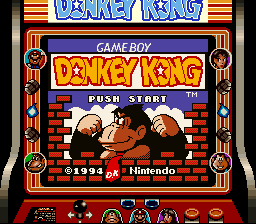Overview
 Donkey Kong enhanced on Super Game Boy
Donkey Kong enhanced on Super Game BoyDonkey Kong (sometimes referred to as "Donkey Kong '94" or "Game Boy Donkey Kong") is a puzzle-platforming game developed and originally published by Nintendo in 1994 for Game Boy. In addition to featuring four classic levels from the original Donkey Kong arcade game, Mario's quest to rescue Pauline from the titular ape is expanded to include ninety-seven brand-new levels while introducing several new gameplay mechanics. Donkey Kong Jr. also appears in certain stages to assist his father and make progress more difficult for Mario.
Donkey Kong is notable for its heavy cross-promotion with the Super Game Boy accessory for SNES. When played on Super Game Boy, the game features an enhanced color palette and limited voice samples, as well as a unique frame border resembling the original Donkey Kong arcade cabinet.
It was re-released on the Nintendo 3DS eShop as a Virtual Console title in 2011.
Gameplay
As in the original arcade game, Mario serves as the player character. His primary skill is jumping, which allows players to traverse each level's platforms and avoid various hazards such as touching a dangerous enemy or suffering a fatal drop. Hammer items placed in certain levels can be used to destroy most enemies; however, Mario cannot jump while using a Hammer. Unless the player is holding certain items which can act as an improvised shield, any damage dealt against Mario usually leads to instant death.
![An update of the arcade version's classic]() An update of the arcade version's classic "25m" level
An update of the arcade version's classic "25m" levelMario sports a handful of new abilities in order to account for the game's expanded scope. He can pick up and throw certain objects and enemies in a manner similar to Super Mario Bros. 2, which is critical for solving many puzzles. The Hammer can be thrown in the same way, potentially allowing players to retain this powerful item between separate platforms if they can catch the Hammer again before it falls out of reach. In addition to his basic jump, Mario can now jump even higher by performing a handstand, or by changing his running direction just prior to jumping. While hand-standing, Mario can also use his feet to catch falling barrels. With proper timing, Mario can execute a triple-jump to reach even greater heights. He can even hang onto ropes, allowing Mario to shimmy across with his hands or spin in place. Mario can be launched across great distances if the player jumps while spinning on a rope.
In most of the game's levels, Mario must retrieve a Key and carry it to the level's locked exit. This is accomplished by evading or destroying enemies and maneuvering around obstacles while holding onto the Key. Players can choose to temporarily drop the Key, which is necessary to complete many levels; however, the Key will return to its point of origin if Mario doesn't retrieve it again within several seconds.
Other than the Hammer, there are no power-ups; Mario's core abilities remain static throughout the game. However, there are extra lives scattered throughout many levels. Players can also collect Pauline's hat, parasol and handbag in any level that also contains a Key. If all three of Pauline's accessories are collected in a single level, players can play a mini-game to earn extra lives following their completion of the level.
Boss Levels
 A typical boss fight with Donkey Kong
A typical boss fight with Donkey KongEvery fourth level, Mario encounters Donkey Kong himself, who will attempt to slow Mario's progress with various hazards as he did in the original arcade game. Simply reaching Pauline will complete these levels.
At the end of each Stage, Mario and Donkey Kong face each other in a more direct boss fight. Mario must defeat Donkey Kong by hitting him with the barrels that he flings continuously. After hitting Donkey Kong three times, the ape will run off with Pauline again and proceed to the next Stage. A short cutscene plays following each encounter with Donkey Kong; these scenes typically demonstrate one of Mario's abilities or introduce a new gameplay mechanic.
Stages
The game's first Stage is made up of four levels and follows the same basic format as the original arcade game. In three of these levels, Mario must simply reach the upper platform where Pauline is being held captive by Donkey Kong without losing a life. The fourth level requires Mario to remove several rivets securing the girders that support Donkey Kong by moving across each of them. However, unlike the arcade game, this Stage does not repeat with an increase in difficulty once the fourth level is completed. Instead, Donkey Kong immediately recovers from his defeat before grabbing Pauline yet again and fleeing towards the first of several entirely-new Stages.
 Level 1-1
Level 1-1Following the initial arcade-based Stage, Mario's goal in each non-boss level is to retrieve a Key and carry it to a locked door leading to the next level. Each Stage's individual levels are typically built around a particular mechanic that players must utilize to make progress, such as pulling lever switches to extend bridges or pressing buttons to create ladders.
Including the arcade levels, Mario's adventure spans across a grand total of one-hundred one separate levels.
Log in to comment